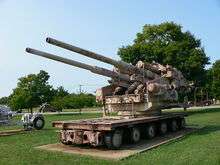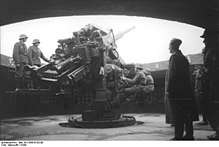12.8 cm FlaK 40
| 12.8 cm Flak 40 | |
|---|---|
 A static mounted 12.8 cm Flak 40. | |
| Type | Anti-aircraft gun |
| Place of origin | Nazi Germany |
| Service history | |
| In service | 1942–45 |
| Used by | Nazi Germany |
| Wars | World War II |
| Production history | |
| Designer | Rheinmetall-Borsig |
| Designed | 1936 |
| Manufacturer | Rheinmetall-Borsig |
| Produced | 1942 |
| No. built | 1,125 |
| Variants |
12.8 cm FlaK 40 12.8 cm FlaK 40 Zwilling |
| Specifications | |
| Weight | 17,000 kg (37,478 lbs) |
| Length | 7.835 m (25 ft 8 in) |
| Barrel length | 7.8 m (25 ft 7 in) 61 calibers[1] |
|
| |
| Shell | 128 x 958mm R[2] |
| Shell weight | 26 kg (57 lb 5 oz) |
| Caliber | 128 mm (5.03 in) |
| Breech | Horizontal sliding-block |
| Recoil | Hydro-pneumatic |
| Carriage | Static or railcar mounted. |
| Elevation | -3 to +88 degrees |
| Traverse | 360 degrees |
| Muzzle velocity | 880 m/s (2,887 ft/s) |
| Maximum firing range | 10,675 m (35,025 ft) |
| Feed system | Power rammer |
The 12.8 cm FlaK 40 was a German World War II anti-aircraft gun. Although it was not produced in great numbers, it was one of the most effective heavy AA guns of its era.
History
Development of the gun began in 1936, with the contract being awarded to Rheinmetall Borsig. The first prototype gun was delivered for testing in late 1937 and completed testing successfully. The gun weighed nearly 12 tonnes in its firing position, with the result that its barrel had to be removed for transport. Limited service testing showed this was impractical, so in 1938 other solutions were considered.
The eventual solution was to simplify the firing platform, based on the assumption it would always be securely bolted into concrete. The total weight of the Flakzwilling twin-gun mount system reached 26.5 tonnes, making it practically impossible to tow cross-country. In the end, this mattered little since by the time the gun entered production in 1942, it was used in primarily static, defensive applications. There were four twin mounts on the fortified anti-aircraft Zoo Tower, and they were also on other flak towers protecting Berlin, Hamburg, and Vienna. It is claimed that during the Battle of Berlin the guns on the Zoo Tower were used successfully to support ground forces, "where the heavy 128 mm shells obliterated Soviet armor, especially when hit from the side" . The rush to capture the Reichstag led to dozens of tanks being destroyed. Approximately 200 were mounted on railcars, providing limited mobility.
The gun fired a 27.9 kg (57.2-pound) shell at 880 m/s (2,890 ft/s) to a maximum ceiling of 14,800 m (48,556 ft). Compared with the 88 mm FlaK 18 & 36, the FlaK 40 used a powder charge four times as great.
Variants


- 12.8 cm FlaK 40
- 12.8 cm Flakzwilling 40/2 The 12.8 cm Flak 40 ordnance on a static dual mounting with a total weight of 26 tonnes, capable of firing 20 rounds per minute. Used mainly on flak towers. Production started in 1942 with 10 twin sets produced,[3] another eight in 1943,[3] and in February 1945 a total of 34 were available.[4]
- 12.8 cm PaK 40 A derivative anti-tank gun, rejected in favour of the Krupp 12.8 cm Pak 44, used to arm the Sturer Emil prototypes.
See also
Weapons of comparable role, performance and era
- 120 mm M1 gun, a US gun of almost identical performance
- QF 4.5-inch gun: British 113 mm heavy anti-aircraft gun firing slightly lighter shell
- QF 5.25-inch gun: British 133 mm heavy anti-aircraft gun firing heavier shell
- 5"/38 caliber gun: US Navy single/dual purpose shipboard 127 mm heavy anti-aircraft gun firing slightly lighter shell, used on many U.S. Navy ships built during World War II
References
- ↑ Chamberlain, Peter (1975). Anti-aircraft guns. Gander, Terry,. New York: Arco Pub. Co. p. 23. ISBN 0668038187. OCLC 2000222.
- ↑ "106". www.quarryhs.co.uk. Retrieved 2017-09-11.
- 1 2 Westermann, Edward B. Flak: German Anti-aircraft Defenses 1914-1945 (2005); pp. 108, 128-129.
- ↑ http://www.ww2technik.de/sites/dflak/12,8%20cm%20Flakzwilling.htm
- Gander, Terry and Chamberlain, Peter. Weapons of the Third Reich: An Encyclopedic Survey of All Small Arms, Artillery and Special Weapons of the German Land Forces 1939-1945. New York: Doubleday, 1979 ISBN 0-385-15090-3
- Hogg, Ian V. German Artillery of World War Two. 2nd corrected edition. Mechanicsville, PA: Stackpole Books, 1997 ISBN 1-85367-480-X
- Hogg, Ian V. (2002). Anti-aircraft artillery. Crowood Press. ISBN 1-86126-502-6.
External links
| Wikimedia Commons has media related to 12.8 cm Flak 40. |
- German Flak
- 12.8 cm FlaK 40 Zwilling on display at the U.S. Army Air Defense Artillery Museum